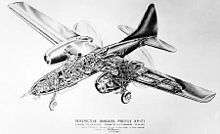Curtiss XP-71
| Curtiss-Wright XP-71 | |
|---|---|
 | |
| Model of the XP-71 | |
| Role | Heavy escort fighter |
| Manufacturer | Curtiss-Wright Corporation |
| First flight | n/a |
| Status | Cancelled in 1943 |
| Primary user | United States Army Air Forces |
| Number built | 0 |
|
| |
The Curtiss XP-71 was a 1941 proposal for a United States advanced heavy escort fighter aircraft.
Design and development
The proposed aircraft was to have a pressurized cockpit. Power would be provided by two Pratt & Whitney R-4360 radial engines each driving a set of pusher contra-rotating propellers.[1]
Based on studies of heavy, long-range fighters that had been undertaken prior to the American involvement in World War II, the United States Army Air Forces initially ordered two prototypes in November 1941.[2] The major role for the proposed aircraft was to act as an "escort" fighter to protect heavy bombers that would have to operate over occupied Europe even if Britain was conquered.[2]
Developed around two turbo-charged 3,450 hp (2,572 kW) Pratt & Whitney R-4360-13 "Wasp Major" pusher radials, the XP-71 would have been the largest fighter aircraft built in the war. The 28 cylinder four-row radial engines were still suffering teething problems; if the proposed engines did become available, their production was completely committed to other large aircraft programs including the B-29 Superfortress and F2G Corsair. The troublesome engine development eventually led to the B-29 using Wright R-3350 powerplants.
The final XP-71 design would have been larger than then contemporary B-25 Mitchell medium bomber and was considered a complex industrial project that would have taxed the resources of the Curtiss company as it was evident that development time would stretch out well beyond the projected need for the type.
At the time, Curtiss facilities were completely committed to producing existing aircraft; due to the need to keep their production lines open for the current types on order and with shifting combat requirements, the USAAF reconsidered the need for the project before prototype construction had begun. As conditions changed and it was clear that Britain would continue to be available for forward bases, the requirement for the advanced fighter project led to the cancellation of the XP-71 in early 1942.[2]
Specifications (XP-71, as designed)

General characteristics
- Crew: 2
- Length: 61.83 ft (18.85 m)
- Wingspan: 82.25 ft (25.07 m)
- Height: 19.0 ft (5.79 m)
- Wing area: 602 ft² (55.9 m²)
- Empty weight: 31,060 lb (14,090 kg)
- Max. takeoff weight: 46,950 lb (21,295 kg)
- Powerplant: 2 × Pratt & Whitney R-4360-13 "Wasp Major" radial engines, 3,450 hp (2,574 kW) each
Performance
- Maximum speed: 428 mph (371 knots, 690 km/h) at 25,000 ft (7,620 m)
- Range: 3,000 mi (2,600 nm, 4,800 km)
- Service ceiling: 40,000 ft (12,192 m)
- Max. wing loading: 51.6 lb/ft² (252 kg/m²)
- Minimum power/mass: 0.147 hp/lb (242 W/kg)
- Time to altitude: 12.5 min to 25,000 ft (7,620 m)
Armament
- Guns:
- 1× 75 mm (2.95 in) cannon
- 2× 37 mm (1.46 in) cannon
See also
- Aircraft of comparable role, configuration and era
- Related lists
References
- Notes
- ↑ Curtiss XP-71 Fact sheet Retrieved: 6 April 2008.
- 1 2 3 Dorr and Donald 1990, p. 124
- Bibliography
- Dorr, Robert F. and Donald, David. Fighters of the United States Air Force. London: Temple, 1990. ISBN 0-600-55094-X.
- Jones, Lloyd S. U.S. Fighters: Army-Air Force 1925 to 1980s. Fallbrook, California: Aero Publishers, Inc., 1975. ISBN 0-8168-9200-8.
External links
| Wikimedia Commons has media related to Curtiss XP-71. |